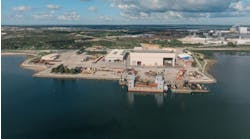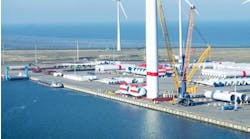View Article as Single page
The VDD 400.2, which will initially work for two years on Heimdal in P&A mode, provides a maximum hoisting capacity of 363 tons, a maximum hoisting speed of 148 ft (45 m) per minute, and a maximum pushing capacity onto tubulars of 90 tons, thanks to the rack-and-pinion drive system. The rig can be moved on two axes and provides an optimal access to different well slots. The rig has a 19-m (62 ft) clear working height, ample for all casing/tool running operations.
The 28-m (91.8-ft) high mast comprises five main segments. On the back of the mast are two drag chains containing all hydraulic power supply/kelly hose mud supply lines, with no sections left to swing free on the drill floor, reducing the risk of injury to personnel. The pipe handling system, which has been adjusted to suit the limited space on the Heimdal platform (and the lack of an available pipe deck) can accommodate tubulars in diameters ranging from 2.5 to 20 in. Up to 150 tons of tubulars can be supported on the 220-ton pipe deck: these are lifted up by the pipe-handling crane (manually operated) and transferred to the pipe feeder machine; thereafter, deployment of the pipes is performed automatically by a PLC. "During this process safety arms close around the tubulars," Beck explained, "so if something goes wrong, the drill pipe cannot fall from the drill floor."
The BOP stack and well control equipment are rated to 10,000 psi. Other drill floor equipment includes a 37½-in. hydraulically driven rotary table, an automated Unitong casing/tubular running system (no specialist casing crew required for operation, and no need for separate rig-up to perform these tasks); and a poorboy degasser. The drillers' cabin features two control chairs and provides three modes for operation – drilling, mud systems, pipe handling and the auxiliary winch – with simultaneous remote monitoring from Archer's offices in Stavanger, Norway. Anti-collision systems incorporated in the drilling control systems reduce the likelihood of human error.
Down on Level 4 is the 5,000-psi mud package, comprising four 9.5-ton 750-hp mud pumps, modified by NOV to suit the 12-ton lifting limit; five 98-cu m (3,461 cu ft) mud tanks configured in four tank modules because of space constraints; two hydraulic power units for redundancy, in case one is out of service or undergoing maintenance; two shale shaker modules, each with a flow rate of 3,410 l/min (900 gal/min); and several trip modules.
On the ground-floor level is the power generation package – power for the VDD 400.2 will be supplied from the Heimdal platform and directed to the rig's two 1.75 MVA transformers. The electrical control room features two PLC systems, with an early warning system issuing a prompt if an item of equipment is about to fail, allowing spares to be ordered in advance. A CCTV system operates above the pipe-handling equipment, at the BOP deck, and over the mud pumps, shale shakers, and drill floor.
Following delivery of the rig in June, assembly offshore was due to start in August, mainly using the Heimdal platform's 30-ton lift capacity south crane. According to Beck first to be installed will be the power generation package on the north and east side of the wellbay, followed by the drag chains to connect the power and hydraulic cables to the rig, and then the mast, drill floor and pipe handling equipment. For the BOP control unit, Archer had to add minor support frames within the rig base structure as Statoil now needs the unit's original site for other purposes. These sections will then be skidded to the north to allow for installation of the mud package, block by block, with connection of the drag chains up the mast representing the final piece of the jigsaw. The completed rig will be able to skid in four directions, allowing it to access all well slots.
According to John Lechner, Archer's president North Sea region, the modular rig on Heimdal could be adapted at a later stage for other drilling tasks if required. It is built to Norsok Type 1 standards, with a rated drilling depth to 6,500 m (21,320 ft). "On Maui A, theArcher Emerald drilled three development wells, the longest being 6,534 m (21,431.5 ft)," Archer said, "but there is nothing to stop us using these rigs to go out to 8-10,000 m (26,240-32,800 ft) as well as anyone else."



